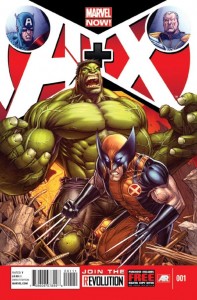 Liberty Annual 2012 — Creators: Various
Liberty Annual 2012 — Creators: Various
This is the Comic Book Legal Defense Fund’s annual moneyraising effort; they’re a First Amendment organization whose primary purpose is to defend comic book retailers (and publishers and creators) from legal challenges when some local parent or prosecutor decides that a comic is obscene. To a journalism major like me, that’s a noble goal; they’ve kept a lot of people out of jail (or from losing their stores) just because they sold someone a comic book. As you might expect, a lot of comics creators appreciate their work, too, so these anthologies are always worth a look: this one has, among others, work from writers like Jonathan HIckman, Kieron Gillen, Howard Chaykin, Andy Diggle and James Robinson, and art from Ben Templesmith, J. Bone, Brandon Graham, Ian Churchill and Terry Moore. The two stars are Gabriel Ba, who provides the beautiful cover image (which, minus a strip of cloth, also becomes the centerfold), and Robert Kirkman and Charles Adlard, who contribute a new six-page Walking Dead story involving the early days of The Governor. Given the circumstances, most of the stories are about freedom of expression, and that gets a little one-note, but with that lineup, and 48 pages for $4.99 — with the money going to a good cause — this is the book of the week.
Just in time for Halloween, this Vertigo anthology resurrects the title of a long-running DC horror book to provide nine eight-page tales of ectoplasmic entities by a number of creators: it’s $7.99, but at 80 pages is just as much a bargain as the CBLDF book. Who’s on board? Gilbert Hernandez’s contribution is probably at the top (after over 30 years of work, he’s become a master of the line like Alex Toth, with a deceptively-cartoony style where every single penstroke is in exactly the right place), but there’s also a Geoff Johns story drawn by Jeff Lemire, a Joe Kubert story done just before his death (shot, uninked, from his loose pencils, a fascinating look at his artistic process), a David Lapham/Paul Pope collaboration, and art from Amy Reeder, Mark Buckingham, Rufus Dayglo, Phil Jimenez, and others. Spend $12 on this and the Liberty Annual, and you’ll have a buffet of top-notch comics creators that should keep you happy for hours.
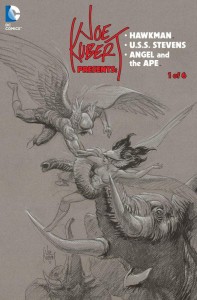 Joe Kubert Presents #1 (of 6) — Creators: Joe Kubert, Brian Buniak and Sam Glanzman
Joe Kubert Presents #1 (of 6) — Creators: Joe Kubert, Brian Buniak and Sam Glanzman
Save $4.99 for this, too — Kubert was working on it when he died, and for a guy with a 70-year+ career, his continuing enthusiasm and ability to generate awesome art was remarkable (only Will Eisner, another Golden-Age star who kept producing right up until the end, can match him). This 48-page book starts with a 22-page Hawkman story entirely by Kubert, adds a manic Angel and the Ape tale by Buniak, follows that with another five-page slice-of-life Kubert contribution shot entirely from his pencils, the first chapter of a story about an orphan who ends up in a whaling ship, and finishes with a ten-page WWII memoir by Glanzman, about his time on the destroyer the USS Stevens. The Buniak is the least of these, but that’s partly because it’s much less serious in tone (presumably, a deliberate choice by Kubert to add balance to the anthology) and partly because it’s hard to compete with old pros like Kubert or Glanzman. All of it’s readable, and the Hawkman story is worth the price of the book by itself — so, like the other two anthologies, this one is highly recommended.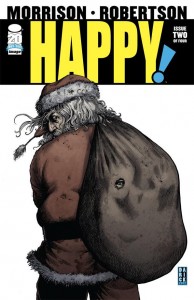
Happy! #2 (of 4) — Writer: Grant Morrison; Art: Darick Robertson
Hit-Girl #4 (of 5) — Writer: Mark Millar; Art: John Romita Jr. and Tom Palmer
Fatale #9 — Writer: Ed Brubaker; Art: Sean Phillips
All three of these books provide combinations of crime fiction and fantasy, navigating the clash between hard-boiled noir reality and… other elements. Happy! is the 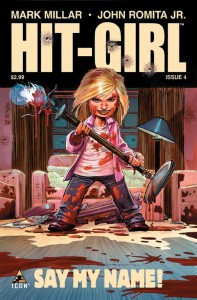 most obvious at this, since its co-star is a cartoon: a tiny, winged, blue talking horse who can only be seen by the hero (he’s apparently the imaginary friend of a little girl who’s being menaced by a serial killer dressed as Santa Claus, who… well, it’s a Grant Morrison story, OK? Just roll with it). This kind of Roger Rabbit scenario would be tough for some artists to pull off, but Robertson’s style is malleable enough to do it easily, combining elements of Raymond Chandler and Walt Disney with aplomb. The whole bit with the hero denying the existence of the cartoon could get old quickly, but with only four issues that shouldn’t be a problem, and when finished this should offer a good palate cleanser
most obvious at this, since its co-star is a cartoon: a tiny, winged, blue talking horse who can only be seen by the hero (he’s apparently the imaginary friend of a little girl who’s being menaced by a serial killer dressed as Santa Claus, who… well, it’s a Grant Morrison story, OK? Just roll with it). This kind of Roger Rabbit scenario would be tough for some artists to pull off, but Robertson’s style is malleable enough to do it easily, combining elements of Raymond Chandler and Walt Disney with aplomb. The whole bit with the hero denying the existence of the cartoon could get old quickly, but with only four issues that shouldn’t be a problem, and when finished this should offer a good palate cleanser 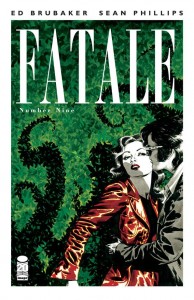 after all those Morrison Batman stories. With Hit-Girl, of course, the fantasy element is that a little girl could also be an unstoppable killing machine. Here, the concept works just because it is so typically Millarian over-the-top, and because the Romita Jr./Palmer art team does such an effective job of selling it to the reader, and making it all look so damned pretty. Fatale, meanwhile, continues its mashup of film noir and Lovecraft elements, with Brubaker and Phillips adding just enough demonic overtones to their standard LA tough-guy detective plot to make it creepy, without crossing the line to silly. The time-jumping narrative (the title woman doesn’t age, so episodes can run from the ’40s through to the present day, and characters can reappear at different stages in their lives, although she always looks the same) makes this a trifle hard to warm up to, but, as with the other two books, it’s undeniably well-done, and probably the smoothest of the lot in its casually-professional storytelling.
after all those Morrison Batman stories. With Hit-Girl, of course, the fantasy element is that a little girl could also be an unstoppable killing machine. Here, the concept works just because it is so typically Millarian over-the-top, and because the Romita Jr./Palmer art team does such an effective job of selling it to the reader, and making it all look so damned pretty. Fatale, meanwhile, continues its mashup of film noir and Lovecraft elements, with Brubaker and Phillips adding just enough demonic overtones to their standard LA tough-guy detective plot to make it creepy, without crossing the line to silly. The time-jumping narrative (the title woman doesn’t age, so episodes can run from the ’40s through to the present day, and characters can reappear at different stages in their lives, although she always looks the same) makes this a trifle hard to warm up to, but, as with the other two books, it’s undeniably well-done, and probably the smoothest of the lot in its casually-professional storytelling.
 Wolverine and the X-Men #19 — Writer: Jason Aaron; Pencils: Nick Bradshaw; Inks: Walden Wong
Wolverine and the X-Men #19 — Writer: Jason Aaron; Pencils: Nick Bradshaw; Inks: Walden Wong
I’m still amazed that Aaron, who proved in Scalped and Ghost Rider that he could be good and mean (his B-movie insticts were refreshingly over-the-top, but cold at the core), manages good and mean and heartwarming in this book; the X-kids, and old mainstays like Kitty Pryde, humanize him, and bring out a humor and warmth that his earlier work lacked. That hits a sweet spot of storytelling, where we come to care about pacifist alien Brood who get half their brains blown out, and where the running joke of Kitty interviewing potential teachers (with cameos galore) ends with a reunion with an old friend that will make old-time readers smile; at the same time, the junior Hellfire Club supplies enough weird nastiness to keep the story moving and the sugar content down. With the end of the Iron Man and Journey Into Mystery and Winter Soldier runs all looming, this is one of the few established and dependably entertaining books left, and it’s good to know it won’t go anywhere for a while.
New Mutants #50 — Writers: Dan Abnett and Andy Lanning; Art: Felix Ruiz and Klebs
The end of the run — Cannonball and Sunspot are moving to the Jonathan Hickman Avengers roster in a month or two — and so there’s a lot of subplot-wrapping and last-act curtain bows. This was a decent book: Abnett and Lanning had a good grasp of the different characters, and their relationships and quiet triumphs and tragedies, and certain moments — the Doug/Warlock relationship, and the battle with their future selves, and the Mephisto-dates-Magma bits — stick in the memory, and will make this a book to be missed.
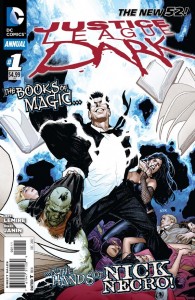 Justice League Dark Annual #1 — Writer: Jeff Lemire; Art: Mikel Janin
Justice League Dark Annual #1 — Writer: Jeff Lemire; Art: Mikel Janin
This does something unusual for a modern DC annual — it actually wraps up a story that’s been in the ongoing title, instead of starting a new one or offering a stand-alone piece. John Constantine, Zatanna, Black Orchid, Frankenstein and company have been chasing the stolen Books of Magic, and trying to get them to Tim Hunter while dodging an old adversary. Lemire’s proven good at this sort of thing already: he knows the characters well, and mixes in a lot of action, reversals, and even a surprise guest star or two; Janin proves decent enough at drawing all the characters well (always a concern with a team book like this), although I’m not that big a fan of his Tim Hunter — but he makes up for it with some nice splash pages, and a good eye for how to compose the occult action scenes. Fans of the supernatural section of the DC universe (who’ve probably been following the regular JLD book anyway) should find the 38 pages of story here well worth their time and $4.99
Batgirl Annual #1 — Writer: Gail Simone; Art: Admira Wijaya and Daniel Sampere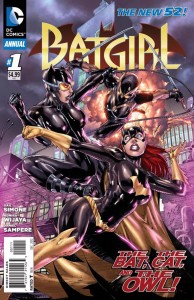
This annual is a stand-alone story, involving the Court of Owls; after the whole Bat-crossover thing with that group, I could do nicely without reading any more stories about them for at least a couple of years — but, fortunately, Simone has a knack for tough-girl dialogue and cool action, and puts it to good use here as she teams up Batgirl and Catwoman, adds in a female Talon who’s conflicted about her loyalties, and blends it all with Wijaya’s moody, painterly artwork; the result is a satisfying story that doesn’t require any prior knowledge of the characters, and has a clear beginning and conclusion — a good example of how to do this type of annual right.
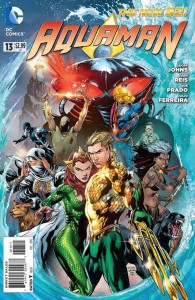 Aquaman #13 — Writer: Geoff Johns; Pencils: Ivan Reis; Inks: Joe Prado and Julio Ferreira
Aquaman #13 — Writer: Geoff Johns; Pencils: Ivan Reis; Inks: Joe Prado and Julio Ferreira
The conclusion to this title’s second major arc, “The Others.” The Reis artwork is a strong point — he’s really hit his stride on this book, and a few of the Aquaman splashes (heh.. I used a water word…) are impressive. On the other hand, the whole “Aquaman was in a superteam before the JLA, but it doesn’t matter because we’re going to kill most of them off” bit wasn’t very engaging, and the Black Manta showdown that’s been building for months ends pretty much the same way every other Black Manta/Aquaman showdown ever has. That’s comic book convention, I suppose, but it feels like Johns being lazy, too, and it makes me wonder how long I’ll keep buying this book.
Ultimate Comics Spider-Man #16.1 — Writer: Brian Michael Bendis; Art: David Marquez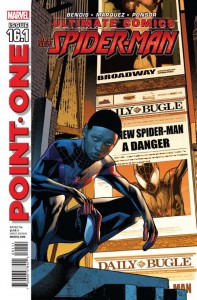
Despite the cover, Miles barely appears in this book; instead, we get Betty Brant (whose Ultimate version is a conniving reporter for the Daily Bugle) trying to track him down and out him as Spidey so she can make big bucks off of it. This is one of those stories that depends on the reader having read all of the other stories in the series to make sense, but, given that, it’s done well, with some unexpected character development (J. Jonah Jameson is much different in this universe than the regular Marvel one) and a conclusion that’s both unexpected and inevitable. With little stereotypical superhero action, the art depends more on human expressions and movement than most Marvel comics, and Marquez is a good choice — he has some of M. D. Bright’s facility with faces and composition, and is able to keep things interesting despite the lack of punching or other violence (at least until the last page…).
 The Mighty Thor #22 — Writer: Matt Fraction; Art: Barry Kitson and Jay Leisten
The Mighty Thor #22 — Writer: Matt Fraction; Art: Barry Kitson and Jay Leisten
Another ending, as this title concludes to make way for the Jason Aaron/Esad Ribic Thor #1 in a month or so. Fraction’s run on this book has never been as acclaimed as his Iron Man one, and rightly so — his heart was more with Tony Stark’s brilliant, self-obsessed addictive personality than the God of Thunder’s warrior one — but he’s still made this a readable, adventure-filled book, and his “Everything Burns” crossover with Kieron Gillen’s Journey Into Mystery the last few months has ensured that it’s going out at the top of its game. Here, Odin’s back, and Thor goes on trial for… well, for being a dick, pretty much, and a lot of it’s true — but Fraction also shows why he’s necessary for Asgard, and their heart and soul. It makes a fitting coda to “EB,” and a good place to end this incarnation of the title.
Lot 13 #1 (of 5) — Writer: Steve Niles; Art: Glen Fabry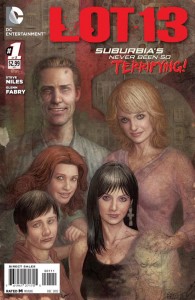
A Virginia family moving into a new house finds that it isn’t ready, so they have to rent rooms in a mysterious apartment building for a few days — one that’s built on the scene of an unjust trial in the 1670s… and, of course, anyone who’s seen Poltergeist knows where this is going. Fortunately, Niles has a deft hand for this sort of creepy tale, and Glenn Fabry has the chops to make the bickering-everyday-family scenes and the horror ones convincing (this first issue being mostly setup, there’s little horror yet, but check out Thor: Vikings to see how he does with horrendous zombie monsters).
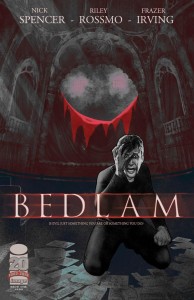 Bedlam #1 — Writer: Nick Spencer; Art: Riley Rossmo
Bedlam #1 — Writer: Nick Spencer; Art: Riley Rossmo
Spencer offers a twisty tale of a Joker-type serial killer here, and he’s going for the kind of stomach-churning dread that a true psychotic can generate (and that Heath Ledger acted out so convincingly on screen). Rossmo offers a sketchy, partly-surreal style that’s about halfway between realistic and, say, Ben Templesmith, and it’s a good match to the story. There are the usual problems with logic with this kind of character — the cops never take his mask off, and there’s the feeling that if someone would just put a bullet into his brain all the problems would be solved — but Spencer plays with those conventions and makes them work, and this looks to be another indy hit from Image. Props to Jean-Paul Csuka, the colorist, for using a subtle, subdued palette except for the color red, which just leaps off the page straight at the reader, and to the creators for making this first issue 48 pages of story for $3.50, certainly the best deal of the week.
This is a new team-up anthology, modeled on the AVX book that just offered heroes beating the snot out of one another; now, post Avengers vs. X-Men, each story involves one Avenger and one X-Man teaming up to beat the snot out of someone else. In the right hands, this can be fun, and here there’s an 11-page Cap/Cable story by Dan Slott and Ron Garney, plus a 10-page Hulk/Wolverine tale by Jeph Loeb and Dale Keown. Everybody seems to be having a lot of fun with this (as with AVX, the first-page, snarky-fanboy summary of the book’s purpose is half the enjoyment) and if you enjoy quick-and-dirty superhero stuff, you could do a lot worse.



